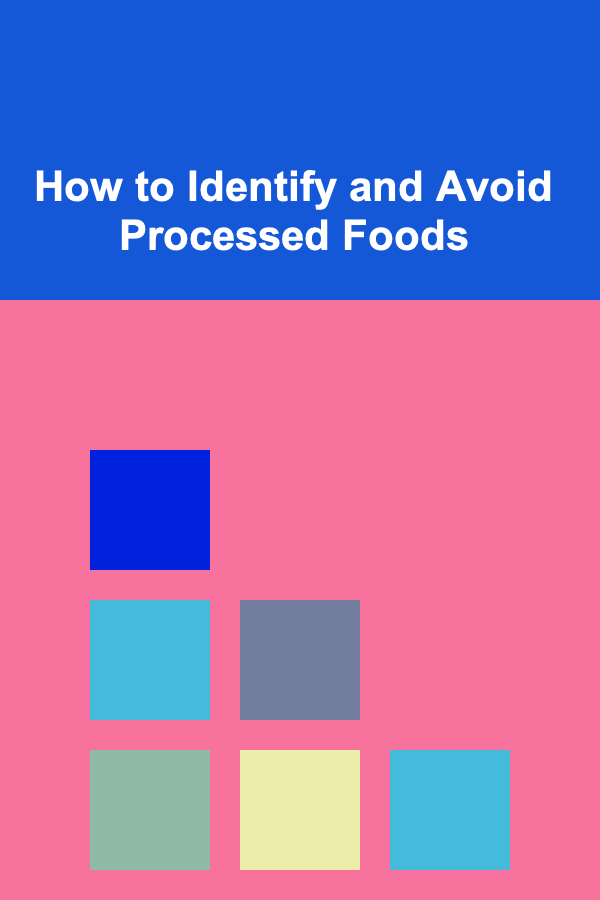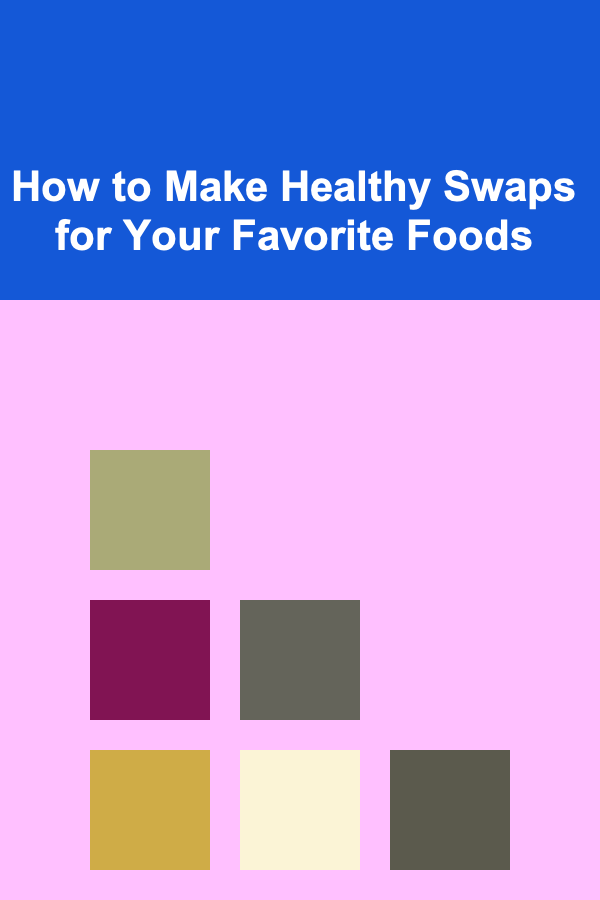
How to Identify and Avoid Processed Foods
ebook include PDF & Audio bundle (Micro Guide)
$12.99$6.99
Limited Time Offer! Order within the next:

In today's fast-paced world, processed foods are often seen as a convenient solution to our busy lives. With a variety of ready-to-eat meals, snacks, and drinks easily available, processed foods have become a staple in many households. However, the long-term health implications of a diet rich in processed foods can be harmful. From weight gain to increased risk of chronic diseases like diabetes and heart disease, processed foods are often packed with unhealthy fats, sugars, artificial preservatives, and other chemicals that may be detrimental to our health.
In this article, we will delve into how to identify processed foods, the negative health impacts they can have, and most importantly, how to avoid them. By the end, you'll have a clear understanding of the role processed foods play in our diets and how to make more mindful food choices that promote long-term health.
Understanding Processed Foods
Before learning how to avoid processed foods, it's important to understand what they are and why they are so prevalent in modern diets.
1.1 Definition of Processed Foods
Processed foods refer to any food that has been altered from its original form through methods like canning, freezing, packaging, or adding artificial ingredients. While some processing, like washing or freezing fruits and vegetables, is considered harmless and even beneficial in preserving nutrients, many processed foods go through more intensive processes that strip them of their natural nutrients and introduce harmful additives.
The level of processing varies, and foods can be categorized into different groups based on how much they've been altered:
- Minimally Processed Foods: These are foods that have been lightly altered, such as washed vegetables, frozen fruits, and whole grains. These foods retain most of their original nutritional value.
- Processed Culinary Ingredients: This group includes things like oils, sugar, and salt that are extracted from natural sources but are often used in cooking to enhance flavor.
- Processed Foods: Foods like cheese, canned vegetables, or smoked meats fall into this category. They have been altered to extend shelf life or enhance flavor but still contain most of their original nutrients.
- Ultra-Processed Foods: This category includes products like packaged snacks, sugary drinks, fast food, and ready-to-eat meals. These foods are heavily processed and contain artificial additives, preservatives, flavor enhancers, and sweeteners.
1.2 Why Are Processed Foods Popular?
Processed foods have become popular for several reasons, most notably convenience and cost. With busy schedules and a fast-paced lifestyle, many individuals prefer foods that are easy to prepare, store, and consume. Additionally, processed foods are often more affordable than fresh, whole foods, making them an attractive option for budget-conscious consumers.
However, the rise of processed foods has come with a corresponding increase in health problems, including obesity, diabetes, and heart disease, all of which are linked to diets high in processed foods.
How to Identify Processed Foods
Now that we have a better understanding of processed foods, let's explore how to identify them. Knowing what to look for on food labels and understanding the characteristics of processed foods can help you make more informed decisions when shopping.
2.1 Check the Ingredient List
One of the best ways to identify processed foods is by looking at the ingredient list on the packaging. A food that is minimally processed will typically have a short ingredient list with recognizable and simple items. For example, a bag of frozen peas will list just "peas," while a loaf of whole-grain bread might list "whole wheat flour, yeast, water, salt."
On the other hand, ultra-processed foods contain a long list of ingredients, many of which you may not recognize. These can include artificial flavorings, preservatives, colorants, emulsifiers, sweeteners, and other chemicals designed to enhance taste, texture, or shelf life. Common additives include:
- High-fructose corn syrup (HFCS): A highly processed sugar substitute that is commonly found in sugary drinks and snacks.
- Artificial sweeteners: Chemicals like aspartame, sucralose, and saccharin that are used to replace sugar.
- Preservatives: Ingredients like sodium benzoate and potassium sorbate, which are added to extend shelf life.
- Monosodium glutamate (MSG): A flavor enhancer used in many processed foods.
- Trans fats: Artificial fats used to improve the texture and shelf life of foods, but they are harmful to health.
2.2 Look for Labels with Claims
Processed foods often come with various marketing claims that suggest they are healthy or beneficial, such as "low-fat," "sugar-free," "gluten-free," or "fortified with vitamins." While these claims may sound appealing, they don't necessarily mean the food is healthy. In fact, many processed foods with these labels still contain high levels of sugar, salt, and unhealthy fats.
For example, a "low-fat" snack might be full of sugar and artificial additives to compensate for the lack of fat. Similarly, "sugar-free" products may contain high amounts of artificial sweeteners, which can have their own set of health concerns.
It's important to look beyond these claims and examine the full ingredient list and nutritional information to make an informed decision.
2.3 Understand the Nutritional Information
Processed foods are often high in sugar, sodium, unhealthy fats, and empty calories. To identify whether a food is processed, check the nutritional information, especially the following:
- Added Sugars: Excessive sugar consumption is linked to numerous health problems like obesity, diabetes, and heart disease. Processed foods often contain added sugars, which are not naturally occurring in the food but are added during processing.
- Sodium: Many processed foods are loaded with salt to enhance flavor and preserve shelf life. High sodium intake is associated with hypertension, heart disease, and stroke.
- Trans Fats: Trans fats are artificially created fats that are unhealthy and can increase the risk of heart disease. While many manufacturers have removed trans fats from their products, some still contain small amounts.
- Empty Calories: Many processed foods are high in calories but low in nutrients. These "empty calories" provide little to no nutritional value and contribute to weight gain.
Negative Health Impacts of Processed Foods
The consumption of processed foods has been linked to a variety of negative health outcomes. While an occasional indulgence in processed foods may not cause significant harm, a diet rich in these foods can have serious long-term consequences.
3.1 Weight Gain and Obesity
Processed foods are often calorie-dense and nutrient-poor, meaning they provide a lot of energy but little nutritional value. When consumed in large quantities, these foods can lead to weight gain. Furthermore, the high sugar and fat content in processed foods can trigger cravings, leading to overeating and the development of unhealthy eating habits.
3.2 Increased Risk of Heart Disease
Many processed foods are high in unhealthy fats, such as trans fats and saturated fats, which are linked to increased cholesterol levels and a higher risk of heart disease. Additionally, the excessive sodium in processed foods can contribute to high blood pressure, further increasing the risk of cardiovascular problems.
3.3 Higher Risk of Diabetes
Processed foods, especially those high in refined sugars and carbohydrates, can lead to spikes in blood sugar levels. Over time, these spikes can contribute to insulin resistance, a condition that can eventually lead to type 2 diabetes. Additionally, the high glycemic index of many processed foods can cause rapid increases in blood sugar and insulin levels.
3.4 Digestive Issues
Processed foods are often low in fiber, which is essential for healthy digestion. A diet low in fiber can lead to constipation, bloating, and other digestive problems. The lack of natural nutrients in processed foods can also negatively impact the gut microbiome, potentially leading to an imbalance of harmful bacteria in the digestive system.
How to Avoid Processed Foods
The key to avoiding processed foods is to make informed choices and prioritize whole, unprocessed foods. Here are some strategies to help you avoid processed foods and maintain a healthy diet.
4.1 Cook at Home
One of the best ways to avoid processed foods is to cook meals from scratch. Preparing meals at home allows you to control the ingredients and avoid the unnecessary additives and preservatives found in processed foods. Focus on whole ingredients like fresh fruits, vegetables, whole grains, and lean proteins.
4.2 Shop the Perimeter of the Store
When shopping at the grocery store, stick to the perimeter of the store, where fresh produce, meats, dairy, and whole grains are typically located. The aisles in the center of the store often contain processed and packaged foods that are more likely to be high in unhealthy additives.
4.3 Choose Whole Foods Over Packaged Snacks
Instead of reaching for packaged snacks like chips, cookies, or sugary drinks, opt for whole foods like fruits, nuts, and vegetables. These options are naturally rich in vitamins, minerals, and fiber, providing more nutritional value than processed snacks.
4.4 Read Labels Carefully
As mentioned earlier, reading food labels is crucial for identifying processed foods. Pay close attention to the ingredient list and nutritional information. Avoid foods with long lists of artificial ingredients, preservatives, and added sugars.
4.5 Plan Your Meals and Snacks
Meal planning can help you avoid the temptation of processed foods. By planning your meals and snacks in advance, you can ensure that you always have healthy options on hand and reduce the likelihood of reaching for processed foods when hunger strikes.
4.6 Choose Healthier Alternatives
When you do need to buy packaged foods, look for healthier alternatives. For example, choose whole-grain bread over white bread, or opt for natural peanut butter with just peanuts and salt, instead of varieties that contain added sugar and hydrogenated oils.
Conclusion
Processed foods may be convenient and affordable, but they come with significant health risks when consumed in excess. By understanding how to identify processed foods and making conscious choices to avoid them, you can improve your health and well-being in the long run. Prioritize whole, unprocessed foods in your diet, cook at home when possible, and be mindful of the ingredients in the foods you buy. By taking these steps, you can avoid the harmful effects of processed foods and enjoy a healthier, more balanced diet.

How to DIY Your Own Holiday Tree Skirt and Ornaments
Read More
How to Manage Noise from Neighbors in a Shared Building
Read More
Why You Should Use Zone-Based Organization in the Kitchen
Read More
How to Acquire Basic First Aid Knowledge
Read More
Feng Shui Myths Debunked: What's Real and What's Not
Read More
How to Make Healthy Swaps for Your Favorite Foods
Read MoreOther Products

How to DIY Your Own Holiday Tree Skirt and Ornaments
Read More
How to Manage Noise from Neighbors in a Shared Building
Read More
Why You Should Use Zone-Based Organization in the Kitchen
Read More
How to Acquire Basic First Aid Knowledge
Read More
Feng Shui Myths Debunked: What's Real and What's Not
Read More